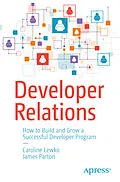Increasingly, business leaders are either looking to start a new developer program at their company or looking to increase the impact of their existing DevRel program. In this context, software developers are finally recognized as legitimate decision makers in the technology buying process, regardless of the size of their organization. New companies are appearing with the sole purpose of making tools for developers, and even companies whose primary focus was elsewhere are waking up to the developer opportunity. Even as the need and demand for DevRel has grown, there are still re-occurring challenges for DevRel leaders.
It is these challenges that this book addresses, covering all aspects of a DevRel program. It is an essential reference to professionalize the practice of developer relations by providing you with strategic, repeatable, and adoptable frameworks, processes, and tools, including developer segmentation and personas, and developer experience frameworks.
In Developer Relations, you'll find the answers to the following questions:
- How do we convince stakeholders to support a program?
- How do we go about creating a program?
How do we make developers aware of our offer?
- How do we stand out from the crowd?
- How do we get developers to use our products?
- How do we ensure developers are successful using our products?
- How do we measure success?
- How do we maintain the support of our stakeholders?
After reading this book you'll have a clear definition of what developer relations is, the type of companies that engage in DevRel, and the scope and business models involved.
Autorentext
James Parton created and ran developer programs for O2 and Telefonica, before joining Twilio as their first hire outside of the US to launch and run their EMEA business until IPO. James has also completed successful two-year board positions with the Application Developer Alliance and the Mobile Ecosystem Forum.
Both authors have operated at leadership level in both startup and corporate DevRel organisations, and run their own consulting businesses. They are passionate about the subject, want to actively improve the understanding of DevRel, and assist with its professionalization.
Inhalt
· FOREWORD by a recognized industry personality e.g. Guy Kawasaki
· Introduction
· Part I: Developing a Common Understanding
There is a lack of definition & detailed understanding of what DevRel actually is. Part 1 of the book sets out a clear definition which identifies and analyzes the constituent parts, looks at how DevRel differs to traditional marketing, where it sits inside the organization and explore how DevRel practitioners need to be equally adept at engaging both inside their organization and outside in their developer communities.
o What is Developer Relations
o The Key Differentiators of Developer Relations
o The Core Components of Developer Relations§ Developer Marketing
§ Developer Experience
§ Developer Success
§ Developer Relations
§ Community
o Where does Developer Relations Fito Inside and Outside
o Developer Relations Test
· Part II: The Keystones of DevRel
Now the reader understands the topic, we move on to discuss the foundational pieces of DevRel. We start with a short history lesson to set the context, moving on to look at the target audience software developers, the business models of DevRel and the typical DevRel roles.
o The History of Modern Developer Relations
§ The Apple Didn't Fall Far From The Tree
§ Developer Relations Traps
§ The Rise of SaaS
§ The Rise of APIs
§ The Arrival of Developer First Companies§ The Rise of Developer tools
§ Why now?
§ Case Study: Mobile Apps - Those that didn't believe
o The Audience: Developers
§ Millions and Growing§ Developer Characteristics
§ Still a Novice Group that Self Learns
§ Developers lack diversity
§ Developers are a technical crowd and don't like to be 'marketed to'
§ Developers are creative (mostly)§ What Drives Developers?
§ Developers as Decision Makers
§ How are Decisions Made? The Decision Making Unit
o The Business Model: B2D
§ Developer First
§ Developer Plus
§ Adoption and Value
§ Types of B2D business models§ B2D model for APIs
§ How many companies practice Developer Relations?
o The Role and Activities
· Part III: The Strategic Alignment of Your Program
With the DevRel Primer covered in parts 1 & 2, we move on to look at the strategic alignment of your program inside your organisation. This section provides the strategic framework for a DevRel leader to be successful.
o Get to Know Your Product
o Developer Products
o Your Value Propositiono Corporate Alignment
o Corporate Commitment
o Program Goals
· Part IV: Activating your Strategy
